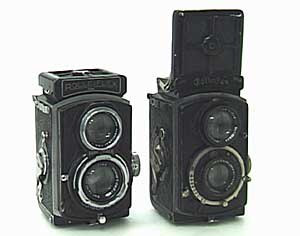


This is 4 x 4cm format RolleiFlex which is almost a size smaller than 6 x 6cm RolleiFlex. In the U.S., this is called "BabyFlex". The most of the structures of RolleiFlex 4 x 4 is as well as RolleiFlex 6 x 6 released in 1932, except that this takes twelve exposures of 4 x 4cm on 127 roll film.In 1932 when this was released, there were not the exposure number for 4 x 4cm format printed on 127 roll film. To solve this problem, Franke & Heidecke KG developed a new machanism that the film stopped automatically when it was transported to the next exposure except that the first exposure was set manually, and this mechanism was employed for RolleiFlex 4 x 4.
The taking lens on this camera is Tessar f3.5/60mm, and the view lens, Heidoscope f2.8/60mm. The shutter employed for this is Rim set Compur whose shutter speeds are B, T, 1-1/300 seconds, and on which the shutter cocking and releasing are made with same lever.
The sport finder is built on the viewfinder.
In 1933, RolleiFlex 4 x 4 was revised in detail that the lens cover was attached to the view lens, and the shutter speed and the aperture value were indicated in the window on top of the view lens.
In 1938, again it was revised that the lens cover was attached to both view lens and taking lens, the bayonet mount was built on the lens and the shutter was changed from Rim set Compur to Compur-Rapid (B, 1-1/500sec.).Although manufacturing of it had stopped once, it came back on the market after the war.
Go to the later version of RolleiFlex 4 x 4.
- First introduced in 1931.
- Camera type : 4 x 4 cm format TLR camera
- Film : 127 roll film
- Taking lens : Tessar f3.5 or f2.8/60mm
- View lens : Heidoscope f2.8/60mm
- Shutter : Rim set Compur (Compur-Rapid from 1938)
- Shutter speeds : B, T, 1-1/300sec. (-1/500sec. from 1938)
- Focusing : lensboard extension
- Film winding : by film wind crank
We use the one of 1938 model for this feature.
|
| Back to Camera Shopper | Back to Index Page |